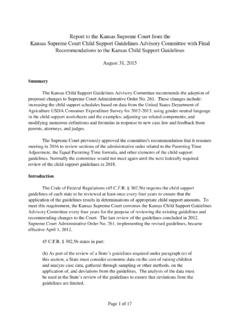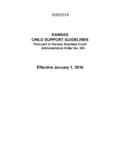Transcription of Culture and Trauma Brief - kscourts.org
1 V1 n1 2005 Promoting Culturally Competent Trauma -Informed PracticesPromoting Culturally Competent Trauma -Informed PracticesNCTSN Culture & Trauma Briefs v1 n1, and Trauma BriefThe National ChildTraumatic StressNetwork promotesculturally competenttrauma treatments andpractices for childrenand adolescentsexposed to Trauma , anddisseminates itsfindings throughfactsheets, Culture andtrauma briefs, andreports. I have a hole inmy roof, but Ihave a biggerhole in my heart,because no oneis looking out forthe kids. --School Teacher inMississippi in theaftermath of HurricaneKatrinaThe National Child Traumatic Stress Network: Who We AreThe mission of the NCTSN is to raise the standard of care and improve access toservices for traumatized children, their families and communities throughout theUnited States. Promoting treatments and services that are culturally competentand Trauma -informed is essential to meeting our mission.
2 Treatment centers fromall over the United States have come together to form a coalition, the National ChildTraumatic Stress Network (NCTSN). The Network, which is currently comprised ofover 40 centers, is funded by the Center for Mental Health Services, SubstanceAbuse and Mental Health Services Administration, US Department of Health andHuman Services through a Congressional initiative, the Donald J. Cohen NationalChild Traumatic Stress Initiative. This Congressional initiative recognizes theprofound, destructive, and widespread impact of Trauma on American children'slives. Its purpose is to improve the quality, effectiveness, provision, and availabilityof therapeutic services delivered to all children and adolescents experiencingtraumatic Impact of Trauma and Culture on Children and AdolescentsResearch indicates that children and adolescents from minority backgrounds are atincreased risk for Trauma exposure and development of Posttraumatic StressDisorder (PTSD).
3 1,2 For example, African American, American Indian, and LatinAmerican children are overrepresented in reported cases of child maltreatment, andin foster Further, research indicates that disasters pose particular burdens inmental health for ethnic minority and developing country populations, especially forchildren, due to social, economic, and political marginalization, deprivation, Consequently, minority children fare worse in the aftermath oftrauma, often experiencing more severe symptomatology for longer periods of time,than their majority group ,6,7 The National Child Traumatic Stress Network Core Data SetOver 25 sites in the NCTSN are currently participating in the NCTSN Core DataSet, which is the largest data collection effort on prevalence and treatment oftrauma among children, to date. The tables below summarize data collected on1,330 children and adolescents across the nation, as of November 2005.
4 Themajority of the sample are racial/ethnic minorities and/or refugees between theages of 5-18 with public insurance or no insurance. The data indicate that there aresignificant differences between racial, ethnic, and refugee/non-refugee groups onlifetime exposure to Trauma for at least 9 different Trauma types. Promoting Culturally Competent Trauma -Informed PracticesNCTSN Culture & Trauma Briefs v1 n1, and Trauma BriefTable 1. Demographic Characteristics of Youth Enrolled in the NCTSN Core Data Set (n=1,330)Mean Age (at NCTSN treatment entry)Age groupings 0-4 5-12 13-18 19+ White African American American Indian Asian Hispanic Non-Hispanic Female Status Public Insurance Private 2. Trauma Exposure* Trauma TypeExperiencedOverallWhiteBlackAmerican IndianAsianHispanicSignificant DifferencesBetween GroupsPhysicalAbuse26%33%23%24%15%33%Yes (X2= , p<.01)Sexual Abuse27%38%19%28%3%29%Yes (X2= , p<.)
5 001)EmotionalAbuse33%42%26%18%21%42%Yes (X2= , p<.001)Neglect27%33%27%15%6%27%Yes (X2= , p<.001)DomesticViolence40%49%35%46%30%53 %Yes (X2= , p<.001)Loss38%43%40%26%9%42%Yes (X2= , p<.001)ImpairedCaregiver36%43%32%37%18%4 7%Yes (X2= , p<.001)CommunityViolence12%8%16%11%6%22% Yes (X2= , p<.01)ComplexTrauma(2+ types)60%69%58%54%39%72%Yes (X2= , p<.001)Note: The NCTSN Trauma exposure questionnaire within the Core Data Set inquires about lifetime exposureto 18 specific types of Trauma . This table includes only those Trauma types that were reported for at least 10%of the overall 3. Trauma Exposure for Youth Whose Families are RefugeesTrauma TypeExperiencedNon-RefugeeYouthRefugee YouthSignificant differencesbetween groups?Physical (X2= , p<.001)Sexual (X2= , p<.001)Emotional (X2= , p<.001) (X2= , p<.001)Domestic (X2= , p<.001) (X2= , p<.001)Impaired (X2= , p<.001)Community (X2= , p<.001)Forced (X2= , p<.
6 001)Complex Trauma (2+ types) (X2= , p<.001) People who loseeverything thatthey themost importantthing to them istheir dignity. Theextent to whichwe don t allowthem to speak tothe re-buildingprocess erodesthe dignity thatthey andtherefore theyneed to be at thetable at everyphase of therecovery efforts. --Russell Jones, PhD,Psychologist Promoting Culturally Competent Trauma -Informed PracticesNCTSN Culture & Trauma Briefs v1 n1, and Trauma BriefAdopting a Broader View of CultureWhile culturally competent Trauma treatment and practices are increasingly recognized asa necessity for quality care, there remains a gap in available data on Trauma exposureamong children from diverse cultural groups. The little research that exists tends to focuson ethnicity and race. The NCTSN has adopted a broader view of Culture in trying tounderstand the impact of Trauma on diverse cultural groups. It is important that race andethnicity do not become proxy terms for other variables related to Culture , such associoeconomic status and acculturation.
7 The NCTSN s initiatives on culturalcompetence, therefore, include representation of other populations who are oftenexcluded from discussions of race and ethnicity, such as immigrant and refugee youth,disabled youth ( , deaf and hard of hearing), homeless youth, lesbian, gay, bisexualand transgendered youth, religious/spiritual youth, and youth living in rural Availability of Expertise in the National Child Traumatic Stress NetworkThe NCTSN includes professionals who have developed treatments for children andfamilies of diverse cultural groups, adapted treatments to account for the important role ofculture, and who have conducted cultural competence trainings nationally andinternationally. Most importantly, the NCTSN is comprised of experienced and expertpractitioners who work directly with children and families from diverse cultural groups intheir communities, each and every day. We have established the NCTSN CultureConsortium as a mechanism to continue to promote culturally competent Trauma -informed Trauma treatments and practices.
8 We have also created a Culture listserv toprovide a forum for engaging in this important discussion about the fusion of Culture andtrauma, and also for obtaining consultation and recommendations for resources. Formore information about these initiatives and/or to join the NCTSN Culture listserv, pleaseemail Susan Ko, PhD at F, Byrne, C, Diaz, E, Kaniasty, K (2002). 50,000 disaster victims speak: An empirical review ofthe empirical literature, 1981-2001. Unpublished Technical Report, National Center for PTSD,Dartmouth Medical School, Hanover, New , L, Stein, Bradley D, Kataoka, SH, Wong, M, Fink, A, Escudero, P, Zaragoza, C (2002).Violence exposure, posttraumatic stress disorder, and depressive symptoms among recent immigrantschoolchildren. Journal of the American Academy of Child and Adolescent Psychiatry, 41(9), Department of Health and Human Services, Administration for Children and Families (2002).
9 ChildMaltreatment 2002. Washington, DC: , D, Preston, A, Kaiser, C, Olivera, V, Valdez J, Schlueter S (2002). Hurricane George: A cross-national study examining preparedness, resource loss, and psychological distress in the US VirginIslands, Puerto Rico, Dominican Republic, and the United States. Journal of Traumatic Stress, 15, , JA, Deblinger, E, Mannarino, AP, de Arellano, MA (2001). The importance of Culture intreating abused and neglected children: An empirical review. Child Maltreatment, 6(2), , RT, Hadder, J, Carvajal, F, Chapman, S, Alexander, A (in preparation). Conducting research indiverse, minority, and marginalized communities. In F Norris, S Galea, M Friedman, P Watson,Research Methods for Studying Mental Health After Disasters and Terrorism. New York: Guilford , , & Alegria, M. (2005). Mental health care for ethnic minority individuals and communities inthe aftermath of disasters and mass violence.
10 CNS Spectrums, 10(2), Brief was prepared by Susan Ko, PhD, National Center for Child Traumatic further detailsregarding theinformation presentedin this Brief , or to jointhe NCTSN CultureListserv,please contactSusan Ko, PhD by telephone at(310) 235-2633 more informationabout the NationalChild Traumatic StressNetwork, go









